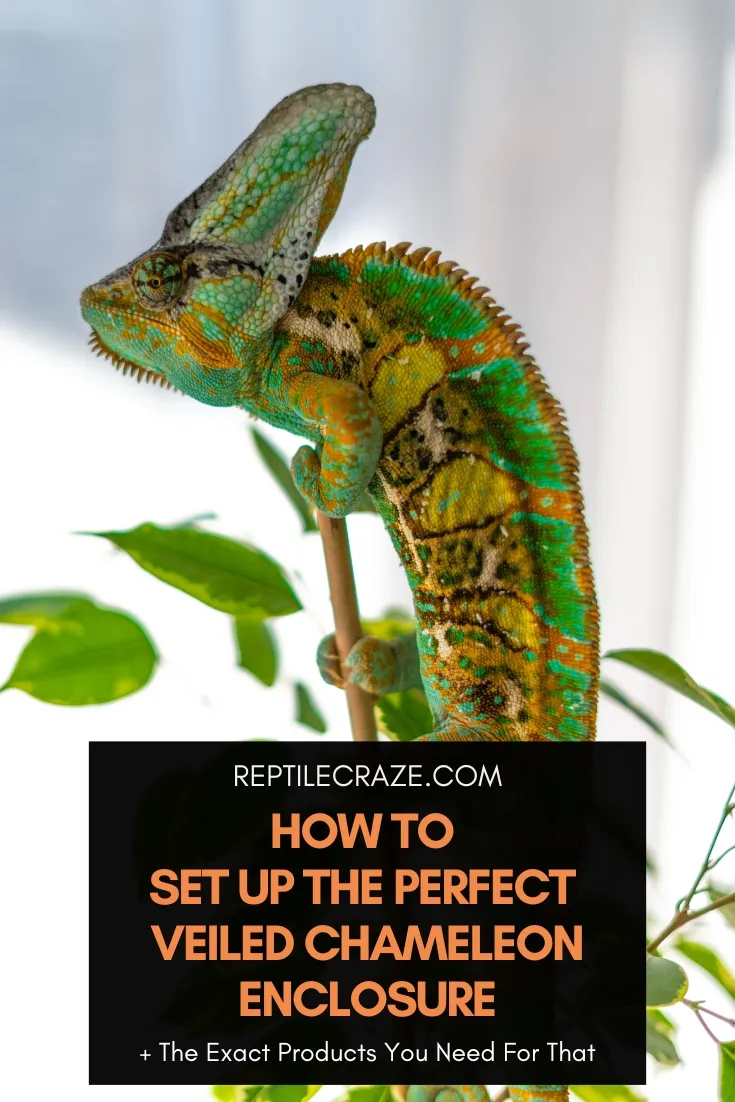
How do you set up a perfect veiled chameleon cage? As veiled chameleons need consistent humidity levels, it is essential to set up an enclosure that can help with humidity but also be able to release air for proper ventilation. What should you put inside the enclosure of a veiled chameleon?
A veiled chameleon cage should be a tall and vertical enclosure that has a means for misting, maintaining humidity, and proper drainage. It should also have good ventilation, UVA and UVB lighting, and plants for their climbing and enrichment needs.
In this article, we will guide you on how you can set up a perfect veiled chameleon cage. We will also recommend tried and tested products so you do not need to go through the hassle of finding the right products. We have a lot to cover, so read on!
Table of Contents
The Perfect Veiled Chameleon Cage
Here is a checklist for setting up a veiled chameleon enclosure. We will show you the right products for that later in the article.
- Enclosure
- Size
- Adult male veiled chameleon: 24″x24″x48″ (length x width x height)
- Small adult female veiled chameleon: 18″x18″x36″
- Baby veiled chameleon: 16″x16″x30″
- Type of Enclosure
- Glass: Good for maintaining humidity, and you can use a screen top cover for ventilation
- Screen: Increases airflow inside the cage so as not to trap stale air
- Hybrid: A combination of glass and screen
- Size
- Placement of Enclosure
- Must be placed in a quiet area and the view should not have other animals visible as it can stress the veiled chameleon.
- It should also not be placed near a window that can alter humidity levels.
- Heating
- A basking spot is needed.
- The ambient temperature is 72-80 F.
- Lighting
- UVA and UVB lighting should be provided.
- Misting
- Manual misting: You can use spray bottles
- Automatic misting: You can set up an automatic mister
- Supplemental water source: You can use drippers that slowly but constantly can be used by your veiled chameleon to drink.
- Drainage
- DIY a waterproof base and around the enclosure
- Cages that are lined with PVC or screen bottoms can let the water escape and you need to have a drainage tray.
- Drilling holes in strategic areas.
- Plants
- You need to put vines and small branches inside the cage as veiled chameleons love to climb.
- Live plants that are safe to eat.
- Live and potted plants help with humidity.
What Enclosure Should I Get For Veiled Chameleons?
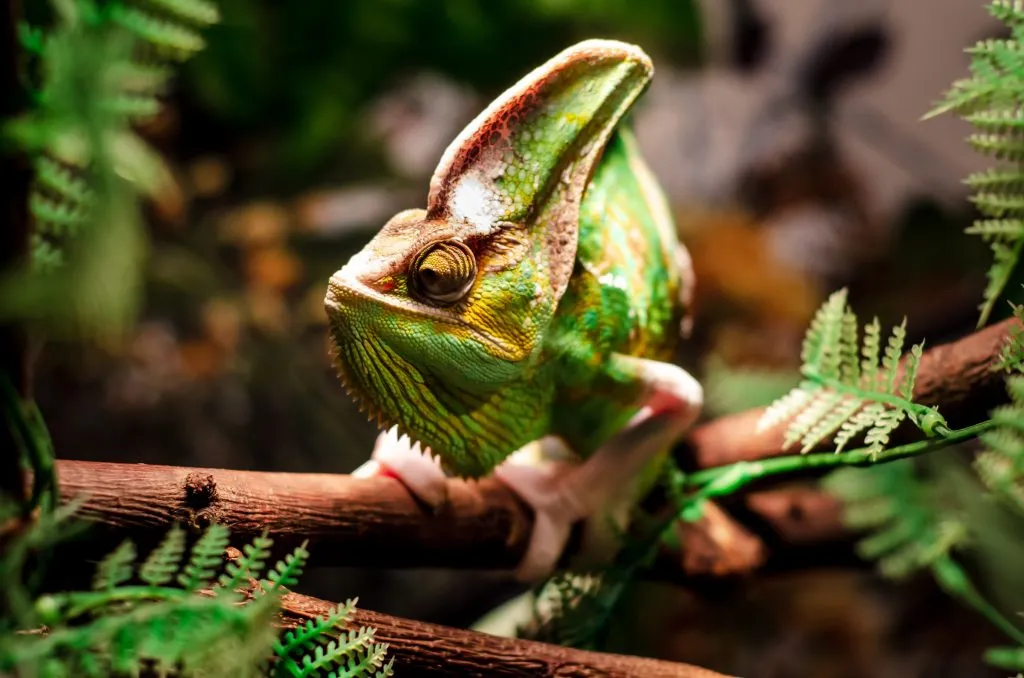
Veiled chameleons are arboreal reptiles, which means that they not only love to climb but they stay at the highest point of the branches for a long time. This is where they feel safe and secure.
This is the reason why it is essential to have a tall and vertical enclosure. Having this type of enclosure assures that you have enough space for your veiled chameleon to climb on vines and branches.
The enclosure dimensions for an adult male veiled chameleon is 24″x24″x48″. If you have an adult female veiled chameleon that is smaller, it can thrive in an 18″x18″x36″ enclosure. For baby veiled chameleons, 16″x16″x30″ should do.
There is an ongoing debate about using a glass or screen enclosure for veiled chameleons. This has something to do with humidity and ventilation.
Our take on this debate is that you can find the right type of enclosure based on your current area and lifestyle. Is your place hot? Will you manually do misting? Where exactly are you going to place the cage?
These questions hint at what will be the best type of enclosure for your veiled chameleon.
Tip: If you need more info on how to care for veiled chameleons, read our guide here!
Glass Enclosure For Veiled Chameleons
Glass enclosures are great for maintaining humidity. However, the biggest concern with this is that stale air tends to be trapped inside a glass enclosure.
When there is no proper airflow, it can lead your veiled chameleon to develop respiratory issues. Further, under constant humidity, glass enclosures prove to be a hassle to clean as water spots easily form.
If you choose to get a glass enclosure like this one for your veiled chameleon, then it is best to balance humidity and airflow by using a screen top.
A glass enclosure will also work well with those who live in cooler areas, as cool air does not retain a lot of moisture.
Further, if you plan on manually misting the enclosure then a glass enclosure will also work for you. The air that is trapped inside can freely escape whenever you do frequent misting.
Screen Enclosure For Veiled Chameleons
A screen enclosure is the best solution for ventilation problems. However, it also presents another problem which is maintaining humidity.
Therefore, a screen enclosure like this one will work best if you are already located in a humid environment. A clue in knowing if your environment is humid is when you reside in a warm area. Air in warm areas tends to hold a lot of moisture.
At the same time, if you intend to place the enclosure in an area that does not have natural airflow, or if it is against a solid surface, then a screen enclosure will also work well.
It is also beneficial to have a screen enclosure if you want to use an automatic misting system. As the misting system has a schedule to spray water inside the enclosure, the humidity is constant, thus there is a larger need for ventilation.
Hybrid Enclosure For Veiled Chameleons
If you want to put the debate to rest and you do not want to deal with balancing ventilation and humidity, then a hybrid enclosure like this one is for you.
Hybrid enclosures usually have glass panels that can help in maintaining humidity but at the same time, it also has screen side meshes to help with ventilation.
Thus, hybrid enclosures will work well whether you live in a warm or cool area.
Where Should I Place The Cage Of My Veiled Chameleon?
The placement of the enclosure itself proves to be of value in creating the right temperature inside the enclosure, maintaining humidity, and access to proper airflow.
Veiled chameleons are solitary reptiles. They prefer to be left alone and they are also shy. Therefore, stimuli from outside of their cages may cause them stress.
Immense stress in veiled chameleons may cause them to get sick or even die.
This is why it is important to place the cage in a quiet area. If you have other reptiles, it is best that the veiled chameleon cage should be placed out of view from the other reptile enclosures.
Further, it is not a good idea to place the cage near a window as this affects the temperature and humidity of the enclosure.
Live plants inside the enclosure will also disrupt the balance of oxygen and CO2 when they react to the natural light that is coming from the window.
How To Heat A Veiled Chameleon Cage
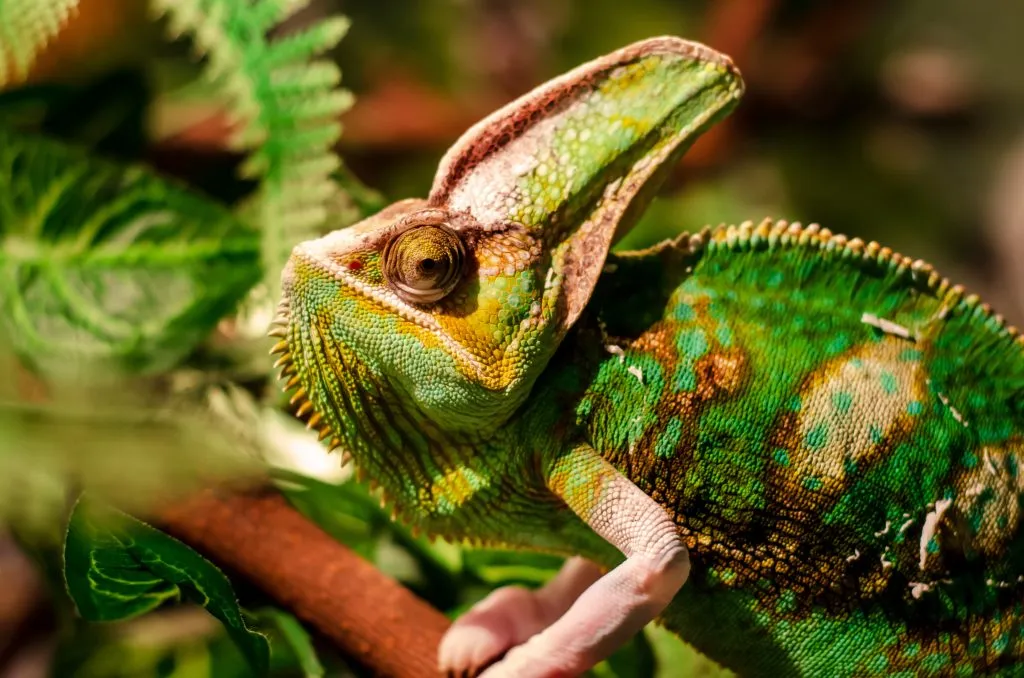
Veiled chameleons are cold-blooded reptiles that need external heat sources to regulate their body temperature. Therefore, you need to set up a heat lamp for the enclosure and also make space for the basking spot.
You do not have to worry that your veiled chameleon will burn under the heat lamp as by instinct, they can gauge whether to move out of the basking spot or stay in it. Here are some heating guidelines:
- The basking spot should not be directly under the heat lamp. It should be at least 12 in. below the heat lamp.
- The temperature of the basking spot should be between 85-95 °F.
- The ambient temperature for the rest of the enclosure should be within 72-80 °F.
- You do not need to keep the heat lamp on at night as veiled chameleons need 12 hours of light and 12 hours of darkness for their natural sleep cycle.
- You can leave the heat lamp off just as long as the enclosure does not cool down below 65 F. If it does, then you need a heat source that does not emit light so as not to disturb the sleep of the veiled chameleon.
The Exo Terra Solar Glo is a fantastic choice as heat lamp for veiled chameleons. It does not only provide ample heat for the entire enclosure, but it also emits UVB.
Therefore, you do not need to buy a separate bulb for UVB needs. You can check out our review here to see how well this bulb performs.
You also need a lamp fixture for the heat lamp. This lamp fixture will fit an E26 socket.
Once you already have your heat lamp, you should not only rely on the UV output printed on the manufacturer’s packaging. Instead, you need to measure the UVI to know the reach of the UV radiation.
In this way, you can accurately pinpoint where you can place the basking spot.
We use the Solarmeter 6.5R to check the UV index. This meter will also help with creating the Ferguson zone of a veiled chameleon which is Zone 3.
The zone range UVI should be 1.0-2.6 and the maximum UVI for the basking spot is 2.9-7.4
You should also check the ambient temperature of the enclosure. You can do so by using an infrared thermometer just like this one.
How To Setup Lighting For Veiled Chameleon Cage
Veiled chameleons need UVA and UVB lighting. As for UVA, heat lamps can provide this. On the other hand, if you only have a heat lamp that does not emit UVB, then you need to purchase a separate UVB bulb.
UVB is essential to veiled chameleons as the rays promote the absorption of calcium in their bones. In turn, having UVB lighting will prevent them from developing Metabolic Bone Disease.
If you already have a chosen heat lamp, then this UVB bulb from Zoo Med will work well. It has a good and consistent UVB reach. You can see the results of our tests in our review here.
If you choose to have two bulbs for heating, UVA, and UVB, then it is practical to get a dual light fixture for a neater lighting setup. This one from Repti Zoo already comes with two separate switch panels.
On the other hand, for a more compact setup, you can opt for a heat lamp that also emits UVB. Our earlier recommendation, which is the Exo Terra Solar Glo will work perfectly.
Humidity In A Veiled Chameleon Cage
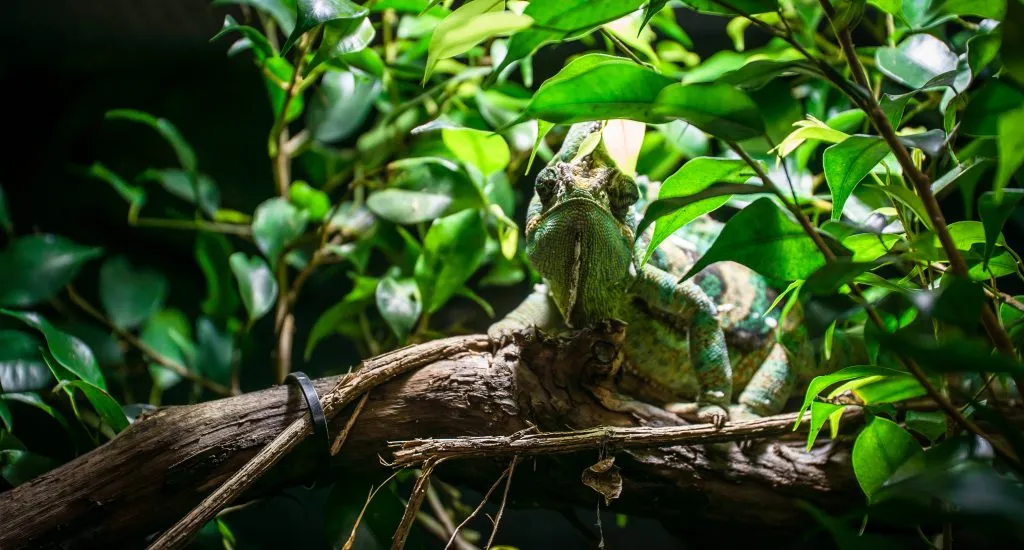
Veiled chameleons need at least 50% humidity. When they are shedding, the humidity should be between 60-70%. You can achieve this by misting the enclosure.
At the same time, the water droplets that are left on the leaves and branches inside the enclosure are the best way for your veiled chameleon to hydrate itself.
It is rare to see a veiled chameleon drinking from a water bowl, so regularly misting its cage ensures that your veiled chameleon will not be dehydrated.
You can use a hygrometer like this one to monitor the humidity levels inside the enclosure of your veiled chameleon.
Here are the different ways to mist a veiled chameleon cage:
Manual Misting
If you have the time to manually mist the enclosure of your veiled chameleon, you can do so by using spray bottles. You can buy spray bottles from your local grocery or hardware store.
If you want to use a spray bottle that has a fine mist, you can check out this mister spray bottle from Exo Terra.
Using a spray bottle with a finer mist gives you more control so you can specifically mist some areas where you want some water droplets to pool.
Automatic Misting
For those who do not have the time to mist the enclosure during the daytime, it is best to get an automatic misting system. This one from Moistenland will do the trick.
You can customize how long the mist will last as well as the specific times when it should start misting.
It is good to invest in an automatic misting system as manually misting the enclosure several times a day can be a hassle and there are times that you may also forget to mist the cage.
An automatic misting system will also be the answer to your problems when you need to go on vacation or you have to be out of the house during the day.
Supplemental Water Source
A dripper system is a way for the enclosure to always have a source of water in between mistings or if the misting fails to provide water droplets for your veiled chameleon to drink.
Having a dripper will not flood the enclosure, as the water slowly comes out of the dripper system. Some owners use a container at the bottom to catch the water, while others let it fall freely.
There are also other owners that set it up in a way that the water drips into a plant pot.
Here is a great dripper system that also blends in with the aesthetic of the enclosure as the dripping water comes out of a plant.
How To Drain Water Inside A Veiled Chameleon Cage
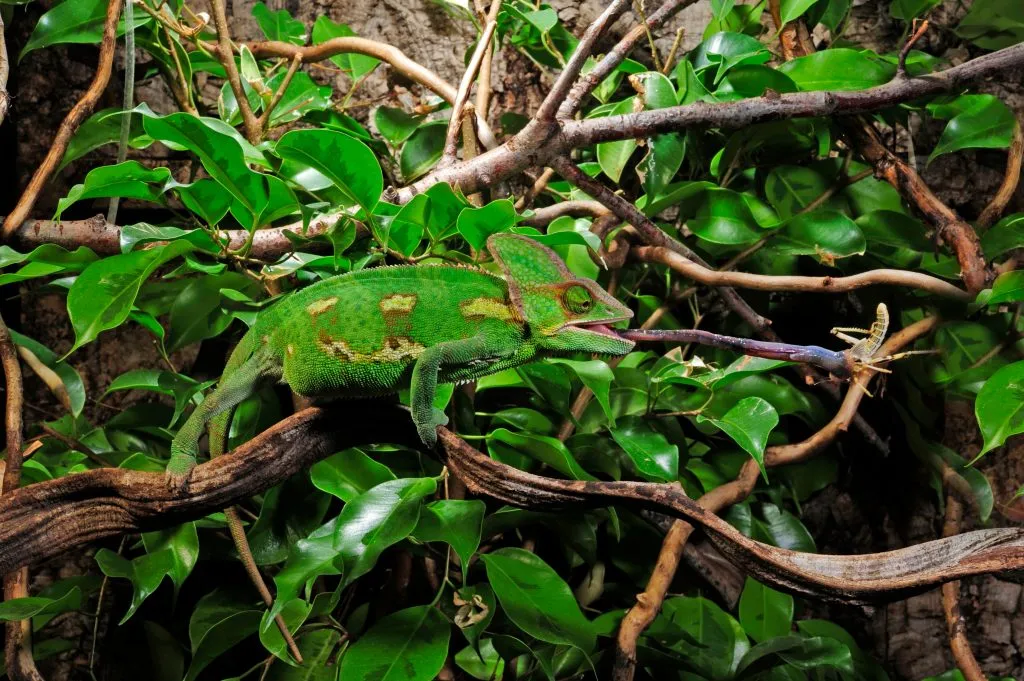
Water is used to achieve humidity in the enclosure, however, water will eventually pool at the bottom of the
Water that is pooled at the bottom will eventually grow bacteria and mold which will be harmful to your veiled chameleon.
If you have a solid bottom in your
You should be mindful when drilling holes under the
To make sure that this will not happen, just drill an appropriately sized hole and also cover it with a screen. If your enclosure has a screen or PVC bottom, then water can freely escape.
You just need to have a drainage tray underneath it to catch the water.
You can also DIY the bottom of the enclosure by using waterproofed wood and sealants. The water will not be absorbed by the wood, and you just need to wipe down the water at the bottom every day.
What To Put Inside A Veiled Chameleon Cage
You can put live potted plants inside the enclosure. Besides the plants, you should also put vines (different sizes) and branches so that your veiled chameleon has a lot of opportunities to climb.
It is actually the best option for a thicker vine to be utilized as a basking spot.
- Here is a good choice for vines. It is a good idea to mix different sizes for the vines.
- These branches can be attached to the glass of the enclosure or you can place them vertically. Make sure to securely attach the bottom to the enclosure.
Make sure that you have a lot of greenery as veiled chameleons will use that to hide or shade themselves. You can make use of both natural and plastic plants and vines.
Some people think that it is dangerous to use plastic decorations as the veiled chameleon may eat it, but, the chameleons actually know that a certain object is plastic and will not ingest it.
In this study, it was suggested to just thoroughly clean any plastic decorations to be rid of unwanted chemicals.
Keep in mind that veiled chameleons are omnivores, so they will eat the live plants inside the cage. Here are some plants that are not toxic to veiled chameleons:
- Golden pothos
- Ficus plants
- Schefflera tree (may be toxic to cats, and dogs, and may trigger allergies on human skin)
- Hibiscus plant
- Grape Ivy
- Areca palm
- Boston fern
- Wandering jew
What Substrate Should I Use For A Veiled Chameleon Cage?

It is not recommended to use a substrate for a veiled chameleon enclosure as it may lead to impaction.
There are some owners that use toilet paper at the bottom, just to catch the water droplets, but this is also not recommended as toilet paper is made from organic material and your veiled chameleon may eat it.
Other owners put in tiles for ease of cleaning and just put potted plants, vines, and branches on them.
There are those who use a reptile carpet, however, we do not recommend it as the material may be too sharp for your veiled chameleon’s body.
Final Thoughts
It may be intimidating to set up a veiled chameleon cage as there are a lot of products to consider and buy.
Just keep in mind that they just need a tall enclosure, UVA, UVB, heating, humidity, and live and plastic climbing surfaces.
With our product recommendations, you are just a couple of clicks away from setting up a hassle-free and perfect veiled chameleon cage.
- Enchi Ball Python: A Unique and Stunning Morph of Python regius - March 27, 2025
- Emerald Tree Monitor: The Enigmatic Green Guardian of the Rainforest - March 26, 2025
- The Egyptian Cobra (Naja haje): A Fascinating Serpent - March 25, 2025




